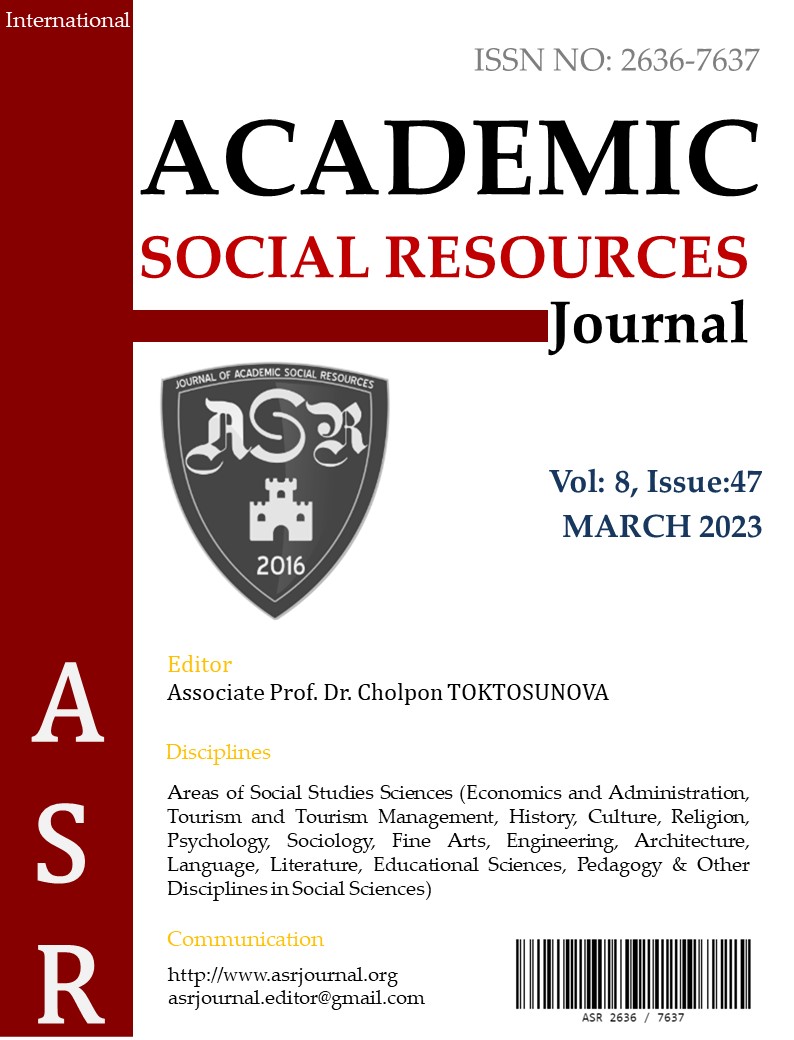Author :
Abstract
Bu çalışma ile Denizli merkez ilçelerinde 2022-2023 eğitim yılında resmi ortaokul, liseler ve BİLSEM’lerde öğrenim gören öğrencilerin nomofobi düzeyleri ve nomofobi düzeylerinin demografik özelliklere göre durumunun ortaya çıkarılması amaçlanmıştır. Araştırma nicel ve betimsel tarama modelindedir. Kolay ulaşılabilir örnekleme yöntemiyle 1723 öğrenciye ulaşılarak ve “Nomofobi Ölçeği” kullanılarak veriler toplanmıştır. Öğrencilerin nomofobi düzeyleri büyük ölçüde ve genel olarak orta düzeydedir. En yüksek düzey iletişim kuramam boyutundadır. Bunu sırasıyla bilgiye erişememe ve rahatlıktan feragat etme boyutları izlemiştir. En düşük ortalama ise “Hafif” derecesinde çevrimiçi bağlantıyı kaybetme boyutundadır. Öğrencilerin nomofobi düzeylerinin kendisine ait oda durumu, evde yaşayan insan sayısı ve ailenin aylık gelir düzeylerine göre farklılık göstermemiştir. Ancak cinsiyet, yaş, okul türü, sınıf ve kullandıkları sosyal ağ sayılarına göre anlamlı farklılık göstermektedir. Cinsiyetlerine göre bütün boyutlarda ve genel olarak kızların erkeklerden daha yüksek düzeyde nomofobi yaşadıkları tespit edilmiştir. Öğrencilerin yaşlarına göre nomofobi düzeylerinin diğer yaşlara göre 14-15 ve 16-17 yaşlarındaki öğrenciler lehine yüksek olduğu görülmüştür. Küçük yaşlardaki öğrencilerin ve 18-19 yaş grubu öğrencilerinin de üst öğrenime hazırlık yaptıkları için daha kontrollü oldukları ve bu nedenle de nomofobi düzeyleri daha düşük çıkmıştır.
Öğrencilerden ortaokul fen liseleri ve BİLSEM öğrencilerinin diğer okul türlerindeki öğrencilere göre nomofobi düzeylerinin daha düşük olduğu saptanmıştır. Sınıf seviyelerine göre ortaokullardaki sınıflara göre 12. Sınıflar hariç liselerdeki sınıfların nomofobi düzeyleri daha yüksek çıkmıştır. Öğrencilerin nomofobi düzeylerinin bütün boyutlarda soyal ağ kullanmayanlarla sosyal ağ kullananlar arasında fark bulunmuştur. Bunun yanında sosyal ağ sayısı 1, 2 ve 3 olanların hem birbirleri ile hem de 4, 5, 6, 7 ve üzeri olanlarla aralarında fark görülmüştür. Öğrencilerin kullandıkları sosyal ağ sayısı arttıkça nomofobi düzeylerinin de arttığı görülmüştür. Günlük telefonda geçen süresi 1 saatten az, 2 ve 3 saat olan öğrenciler arasında ve 1 saatten az, 2 ve 3 saat olan öğrencilerle 4, 5, 6, 7 saat ve üstü olan öğrenciler arasında fark bulunmuştur. Öğrencilerin günlük kullanım süresi arttıkça nomofobi düzeylerinin de arttığı tespit edilmiştir.
Keywords
Abstract
With this study, it was aimed to reveal the nomophobia levels and nomophobia levels of the students studying in official secondary schools, high schools and BİLSEMs in Denizli central districts in the 2022-2023 academic year according to their demographic characteristics. The research is in the quantitative and descriptive survey model. Data were collected by reaching 1723 students using the easily accessible sampling method and using the "Nomophobia Scale". The nomophobia levels of the students are largely and generally moderate. The highest level is in the inability to communicate dimension. This was followed by the dimensions of not being able to access information and giving up comfort, respectively. The lowest average is the extent of losing online connection in the "Mild" rating. The nomophobia levels of the students did not differ according to their room status, the number of people living in the house and the monthly income level of the family. However, it differs significantly according to gender, age, school type, class and the number of social networks they use. It has been determined that girls have higher levels of nomophobia than boys in all dimensions and in general according to their gender. It was observed that the nomophobia levels of the students according to their ages were higher in favor of the students aged 14-15 and 16-17 compared to other ages. Young students and 18-19 age group students were also more controlled because they were preparing for higher education, and therefore nomophobia levels were lower.
It was determined that the nomophobia levels of middle school science high school and BİLSEM students were lower than students from other school types. According to the grade levels, the nomophobia levels of the classes in high schools were higher than the classes in secondary schools, except for the 12th grade. A difference was found between those who do not use social networks and those who use social networks in all dimensions of students' nomophobia levels. In addition, there was a difference between the number of social networks 1, 2 and 3, both with each other and with those with 4, 5, 6, 7 or more. It was observed that as the number of social networks used by the students increased, their nomophobia levels also increased. A difference was found between students whose daily phone time was less than 1 hour, 2 and 3 hours, and between students who spent less than 1 hour, 2 and 3 hours and those who spent 4, 5, 6, 7 hours and more. It was determined that as the daily usage time of the students increased, the levels of nomophobia also increased.
